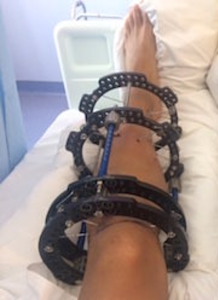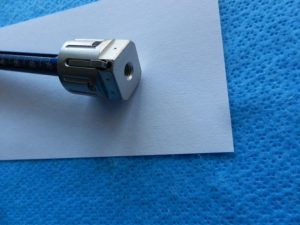When a bone breaks ( either after an accident or when surgically osteotomized), it must be securely fixed with devices or implants in order to create optimum mechanical conditions of stability for the bone to heal. In distracton osteogenesis the fixation device, in addition to mechanincal stability, must be also able to move the fixed bone in a controllled and predictable way to produce the lengthening.
Initially, Ilizarov used what later became the famous ” Ilizarov apparatus” which is a circular external fixator frame. External circular frames where not without problems, so alternative internal implants (i.e. nails) were gradually developed. Nowadays, the most commonly used fixation devices in limb lengthening are the following:
Internal Implants
PRECISE-2 Intramedullary Nail
Precise-2 is the previous generation of PRECISE limb lengthening family of products. Precise-2 was introduced by Nuvasive in 2012.
The main disantvantage of Precise-2 , compared to the newer Stryde, is that it doesn’t allow full weight bearing post-operatively. Although this is reasonably well tolerated in case of unilateral limb lengthening, (or bilateral upper limb) it is not very comfortable and efficient in cases of bilateral lower limb lengthening such as for cosmetic reasons.
Because of Precise-2’s weight bearing restrictions, we now offer Precise-2 in selected cases only and after appropriate consultation. ( See more in Limb Lengthening Options and Financial Considerations.)
X-os G-(Guichet) Nail
G-Nail is based on the successful design of Albizzia nail which was introduced to clinical practice by Dr Guichet in the USA in 1991. The current version of G-nail was developed in 2010 and has been in clinical use continuously since 2010.
G-nail is made of hardened stainless steel, Chromium and Cobalt alloy. This alloy is one of the most well studied and most commonly used in orthopaedic implants of all sorts. It has uninterrupted CE Mark approval in the EU since 2010. No signs of osteolysis related to metal debris and corrosion has ever been recorded and the CE mark was never withdrawn.
G-nail allows full weight bearing with crutches from the day of the surgery.
G-nail allows lengthening of the first 1 cm of lengthening on the day of surgery thus reducing the overall duration of the lengthening period.
G-nail doesn’t require external electrically powered appliances for the lengthening which makes early repatriation of patients at 6 weeks after surgery logistically easier (no need for technical support of the appliance, no problems with customs clearance of the appliance during traveling, no problems with incompatibility with electrical networks in different countries)
More than 700 nails have been implanted so far. The reported mechanical failure rate is less than 2% and the non-union rate is also less than 2%. With the newer anaesthetic protocols pain during performing lengthening manuevers is non-existent or minimal.
An additional advantage of Axos instrumentation is that the femoral osteotomy is performed with the intramedullary low energy saw, allowing the surgeon to do the surgery with less skin incisions.
External Devices
Ilzarov Ring Fixator (Circular Frame)
The Ilizarov circular frame consists of rigid ( metallic or, most recently, carbon fliber) rings which are connected to each other with rods. In the context of limb lengthening, two rings are place around each part (segment) of the bone (i.e above and below the level of the osteotomy). 
The rings work as a scaffold on which the bone is fixed with tensioned fine wires and half pins. The rods that connect the two bone segments can be lengthened ( or compressed) with the turning of nuts.
The Ilizarov circular frame has passed the test of time and it is the most well-studied device in distraction osteogenesis. Nevertheless, it does have its own shortcomings, such us pin-site problems and difficulty with walking, washing and performing daily tasks. Because of these problems it is not well tolerated in the thigh.
In Athens BJR, we do not use circular frames for femoral limb lengthening for any reason.
When we use ilizarov type circular frames in the tibia, we prefer to use the hardware of TSF from Smith & Nephew. The reasons for that are:
- The rings are made of carbon fibers so they are lighter.
- The lengthening device of the frame (graduated telescopic blue rods) allow for a more controlled, easier ( no need to us spanners) and less confusing lengthening for the patient, day in day out.
- We reduce unnecessary device variabiality of in our center and this contributes to increased safety.
References
- C. Fenton, D. Henderson, A. Cherkashin, M. Samchukov, H. K. Sharma. COMPARISON OF THE MECHANICAL PROPERTIES OF THE TL-HEX AND TSF FRAMES. Orthopaedic ProceedingsVol. 100-B, No. SUPP_8
Hexapod Circular Frame (Taylor Spatial Frame TSF)
This section is under construction.
References
Unilateral Modular Rail Lengthening System (MRS)
This section is under construction.
References
In addition to the methods above, which are either purely external or purely internal, combined methods of fixation have been also proposed:
Combined Methods
Lengthening And Then Nailing (LATN)
Limb lengthening with purely external fixation devices entails that the frame has to remain in situ for the whole consolidation period leading to frame times of up to 2 months per cm of lengthening. This prolonged time in a frame confers several disadvantages. First, there is a greater chance of complications like pin-tract infection and decreased range of motion in the surrounding joints. Second, it may have a psychological effect on patients, increasing frustration and decreasing compliance. Finally, when the frame is removed, there is an 8 to 9.4% reported risk for fracture of the regenerated bone due to the lack of any internal stabilization.
LATN was introduced as an idea to reduce the external fixator time and avoid some of the reported limitations and risks of LON including infection, need for acute deformity correction when a deformity is present and inability to distract the bone and achieve the desired lengthening.
External fixation is used for lengthening during the distraction phase and when lengthening is completed then the patient is taken back to theatre and an intramedullary nail is inserted and the frame is removed. The external fixator is applied so that an intramedullary nail can be inserted while the frame is in place, however, without contact between the internal fixation and the external fixation pins and wires. Once length has been achieved, a reamed locked intramedullary nail is inserted across the regenerate bone and the frame is removed. The intramedullary nail supports the bone during the consolidation phase allowing removal of the external fixator after the distraction phase of lengthening.
LATN is now the preferred method (instead of LON) in our centre for bilateral cosmetic tibial lengthening, when purely internal methods are excluded because of financial and funding limitations or when simultaneous correction of bone deformitiy is required.
References
S. Robert Rozbruch, MD, Dawn Kleinman, BA, Austin T. Fragomen, MD, and Svetlana Ilizarov, MD. Limb Lengthening and Then Insertion of an Intramedullary Nail: A Case-matched Comparison. Clin Orthop Relat Res. 2008 Dec; 466(12): 2923–2932.
Lengthening Over Nail (LON)
LON is now used in our center only in cases of unilateral femoral or tibial lengthening after appropriate counselling , when purely internal methods are excluded because of financial and funding limitations.
LON was introduced as an idea to reduce the time spent on an external fixator and the related problems. External fixation is safe, but the consolidation phase tends to take too long. The prolonged fixator time puts the patience of the patient to the test and, when applied to the femur, this prolonged duration tends to increase knee stiffness.
Moreover, eccentric loading of bones in the limb creates a tendency for axial deviation of the regenerate and malunion. Loosening of the fixation pins, instability of the fixator and tightness of muscles increase the tendency for axial deviation in the lengthening phase.
Combining IM fixation with the Ilizarov fixator firstly adds to the stability of the construct. The next benefit of the addition of the IM nail is the prevention of axial deviation during the fixation period and also after removal of the fixator over the long term. This was proved in our series with very low rates of axial deviation.
The greatest concern with LON technique has been the risk of deep bone infection due to close proximity of external pins and the nail. With great care in pin insertion and postoperative care we have not faced this problem in our series. However, the literature has mentioned this problem in the series of Simpson who had three deep infections in twenty LON surgeries. Kristiansen reported giving up on this method to revert back to the Ilizarov technique due to many complications.
The surgical technique of the LON procedure include:
- Preparation (drilling holes) of the osteotomy site.
- Completion of reaming of the intrmedullary canal (to prepare it for the nail).
- Partial application of the external frame (with reamer insitu as a reference to guide external pins and wires clear from the nail.)
- Completion of osteotomy.
- Insertion of the nail and proximal locking only.
- Completion of external frame construct as needed
When the distraction phase is completed, the patient is taken back to theatre where the nail is locked distally with to screws and the external frame is removed. This is a minor procedure which is done as a day case and the patient leaves the hospital on the same day.
References
- Chaudhary M. Limb lengthening over a nail can safely reduce the duration of external fixation. Indian J Orthop. 2008 Jul-Sep; 42(3): 323–329.
- Paley D, Herzenberg JE, Paremain G, Bhave A. Femoral lengthening over an intramedullary nail: A matched-case comparison with Ilizarov femoral lengthening. J Bone Joint Surg Am. 1997;79:1464–80.
- Min WK, Min BG, Oh CW, Song HR, Oh JK, Ahn HS, et al. Biomechanical advantage of lengthening of the femur with an external fixator over an intramedullary nail. Pediatr Orthop B. 2007;16:39–43.
- Simpson AH, Cole AS, Kenwright J. Leg lengthening over an intramedullary nail. J Bone Joint Surg Br. 1999;81:1041–5.
- Kristiansen LP, Steen H. Lengthening of the tibia over an intramedullary nail, using the Ilizarov external fixator: Major complications and slow consolidation in 9 lengthenings. Acta Orthop Scand. 1999;70:271–4.
- Kocaoglu M, Eralp L, Kilicoglu O, Burc H, Cakmak M. Complications encountered during lengthening over an intramedullary nail. J Bone Joint Surg Am. 2004;86:2406–11.
Go back to Limb Lengthening- introduction





